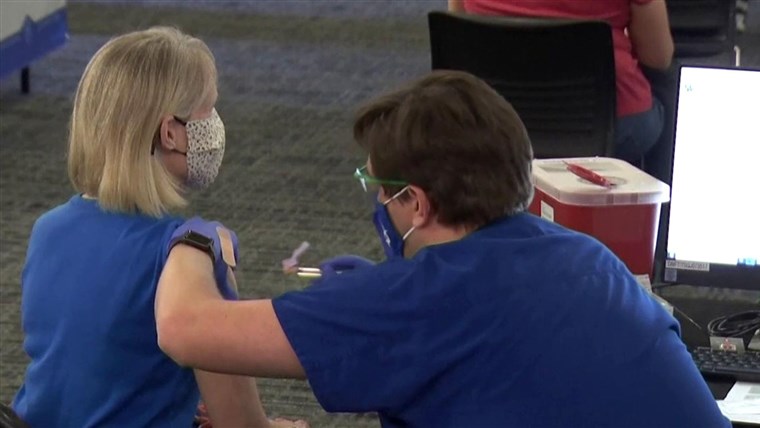More than a year after the pandemic started, Covid-19 is still ravaging parts of the world, but now scientists are warning that another virus could be a serious threat in the coming months: influenza.
This season, the flu virtually disappeared, with less than 2,000 lab-confirmed cases in the United States to date, according to the Centers for Disease Control and Prevention. In a typical flu season, the U.S. could see more than 200,000 lab-confirmed cases by this time of year, a tiny fraction of the true number of cases, estimated to range from 9 million to 45 million annually.
Full coverage of the coronavirus outbreak
Scientists and public health experts say this year, Covid-19 mitigation measures, like social distancing and masking, most likely stopped flu transmission.
But according to scientists like Dr. Andy Pekosz, a professor of microbiology at the Johns Hopkins Bloomberg School of Public Health, a year without much flu could lead to a year with a whole lot of flu.
“We’ve gone over a year without a significant portion of the population getting infected with flu and getting immunity because of that,” Pekosz said. “That could mean that the susceptible people in the population to flu are going to be increasing.”
When someone gets the flu, they usually develop some immunity to the virus. That’s why young children and babies are often the most susceptible to getting infected, because their immune system hasn’t seen the virus yet. But since there was such little influenza circulating this year, the number of people without any prior immunity could double.
“With low level population immunity, that could bring about more cases,” said Scott Hensley, a microbiologist at the University of Pennsylvania Perelman School of Medicine. “We could see more pediatric deaths and, concurrent with that, a rise in cases within the whole community. That’s because overall population immunity is predicted to be low.”
Scientists say another aspect of this unusual flu season is that there doesn’t appear to be many flu strains circulating.
“It’s interesting,” Hensley said. “Typically, there’s a lot of genetic diversity of these viruses.”
It’s unclear whether there are actually fewer strains circulating, or if there has just been limited sampling of the virus because there have been so few cases, meaning it may be possible other strains are out there that haven’t been detected.
Which of these scenarios turns out to be the case could have a significant impact on next season’s flu vaccine, which is made yearly to protect against the most prominent virus strains circulating around the globe.
Download the NBC News app for full coverage of the coronavirus outbreak
“Generally, we want less genetic diversity,” said Sarah Cobey, an epidemiologist and evolutionary biologist at the University of Chicago.
If there are truly fewer strains circulating, then the vaccine stands a better chance of being a good match, making it more effective. In recent years one prominent strain, H3N2, has been problematic since there were so many substrains of it, making it more difficult for a vaccine to broadly protect against it, Cobey said. So far this year, few strains have been identified.
But if the real issue is that there just hasn’t been enough sampling, then that could translate to the vaccine being a bad match, causing problems with protection.
“Since we have had so few cases, we’re using a small number to make our choices from,” Pekosz said. “There could be strains circulating at a low number that could come to dominate. We worry about that normally in every flu season, but usually we have a much larger data set to choose from.”
The World Health Organization selected the strains for the next flu vaccine in February, based on what’s been circulating around the globe. Scientists often pay particular attention to strains in the southern hemisphere, where flu season starts in June and typically peaks in August. Virus activity in that region is often a bellwether for what’s to come in the U.S.
“The pattern of influenza activity in the Southern Hemisphere prepares the Northern Hemisphere for what may happen in their next season,” said Kanta Subbarao, director of the WHO Collaborating Centre for Reference and Research on Influenza. “Often new viruses that are first noted in the Southern Hemisphere spread and become the dominant strain in the Northern Hemisphere.”
Subbarao says there has been no local flu activity in the Southern Hemisphere yet, but it’s still early.
Despite any concerns about effectiveness, the vaccine will still be key to preventing flu. Even if a flu shot is a poor match for circulating strains, it still gives some protection and reduces a person’s risk of hospitalization and death.
“A lot of this is out of our hands,” Hensley said. “The one thing we can do is to get vaccinated. If there was ever a year to get vaccinated, this is the year to do that.”
“A lot of this is out of our hands,” Hensley said. “The one thing we can do is to get vaccinated. If there was ever a year to get vaccinated, this is the year to do that.”
Scientists also reassure that it’s not all doomsday scenarios. Indeed, predicting anything about flu is an unusually tough task. While the virus was isolated for the first time more than 80 years ago, scientists say there’s still a lot to learn.
“What’s really challenging about influenza is that it’s fast evolving,” Cobey said, adding that it appears to mutate faster than SARS-CoV-2, the virus that causes Covid-19. “Every year we are seeing flu viruses that have never been on this planet.”
Dr. Jesse Goodman, professor of medicine and infectious disease at Georgetown University and former chief scientist at the Food and Drug Administration, said he believes the American population has learned a lot from Covid-19 and may carry on mitigation measures like frequent hand washing and even social distancing.
“If some of these practices continue, it could be that things aren’t bad next year,” he said. “One question will be, how much will those habits persist?”
Follow NBC HEALTH on Twitter & Facebook.










Recent Comments